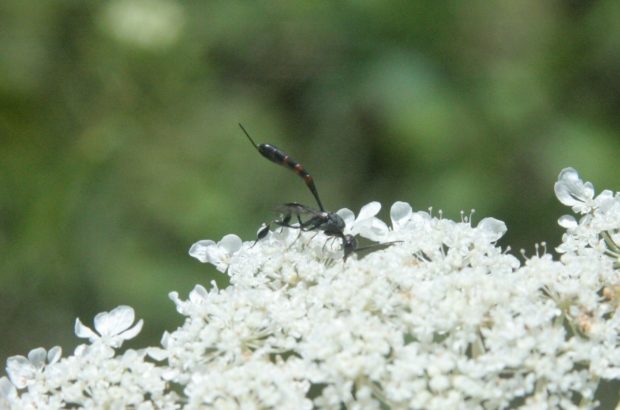Insects

Megachile inimica Added to Vineyard Bee List
Megachile inimica, a large species of leaf-cutter bee, was found in the community garden at Thimble Farm in late September 2023. It representes the 197th species of bee documented on Martha’s Vineyard.

Cyrtopogon falto
Cyrtopogon falto is the latest robber fly species (Asilidae) to be documented on Martha’s Vineyard.

New Bee Species for Martha’s Vineyard
The Azalea Mining Bee, Anderna cornelli, has been found on Martha’s Vineyard, raising the total of bee species known on the island to 193. Sharon Britton found several individuals on rhododendron flowers in her yard in West Tisbury.

Cuckoo Bees
These fascinating bees are kleptoparasites of other bees, laying their eggs in the nests of their host species instead of provisioning there own nests. One cuckoo bee, Coelioxyx octodentatus, was recently added to the Vineyard’s Bee checklist.

Hairy-banded Mining Bee – Andrena hirticincta
The Hairy-banded Miner Bee, Andrena hirticincta, is one of the most recognizable solitary bees known from Martha’s Vineyard, occurring in late summer and early fall wherever goldenrod, this bee’s favorite pollen source, is found.

Great Blue Skimmer
A new iNaturalist user recently documented a great blue skimmer (Libellula vibrans) in Chilmark. There are only a handful of previous records for the Vineyard.

Carrot Wasp
A Chilmark record adds the unusual wasp genus Gasteruption to the MV Atlas of Life.

Monarch Butterflies – How Endangered Are They?
This iconic orange-and-black butterfly is widely assumed to be at risk of extinction. But Monarch biology is complex, with different populations exhibiting different ecology, and some research suggests that the situation is less dire than widely believe.

White Colic-root
This member of the lily family is a characteristic plant of the Vineyard sandplain and a popular place to stop for a wide range of pollinators.

Shed Some Light on Moths
Diverse, ecologically important, and often stunningly beautiful, moths have emerged as a popular subject of study among amateur naturalists.